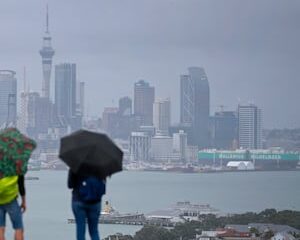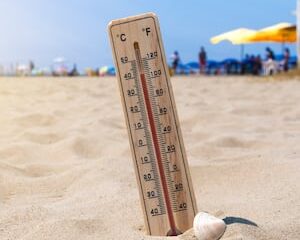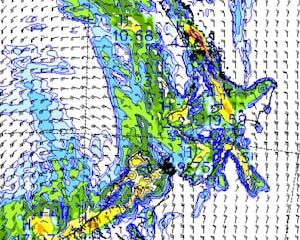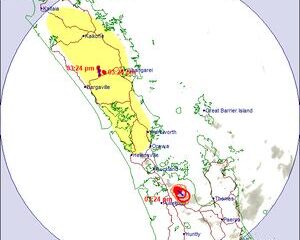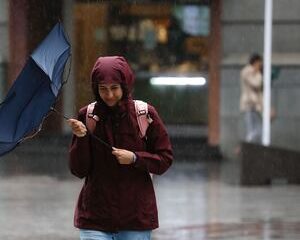Science
Laser Research Project Launches to Study Aerosols Near Invercargill

A significant atmospheric research initiative commenced at the MetService site close to Invercargill Airport, aiming to investigate the effects of aerosols on the atmosphere. The project, named goSouth-2, is a collaborative effort involving several institutions from Germany and New Zealand. The German partners include the Meteorological Institute of the University of Leipzig and the Leibniz Institute for Tropospheric Research (TROPOS). New Zealand participants are MetService, the University of Canterbury, and The Air Quality Collective.
As preparations continue ahead of the project’s official launch on September 3, 2023, a team of five TROPOS researchers is busy setting up equipment at the site. According to Dr. Patric Seifert, a researcher at TROPOS, aerosols—tiny airborne particles—originate from various sources, both terrestrial and marine. These particles encompass salt, dust, pollen, and emissions from smoke or volcanic activity.
Dr. Seifert emphasized the critical role that aerosols play in cloud formation, acting as nuclei that allow cloud particles to cluster. He stated, “The less aerosol particles are available, the less cloud particles can form, and vice-versa.” The unique geographical location of southern New Zealand, particularly at the northern edge of the Southern Ocean, provides an ideal setting for studying the interaction between aerosols and clouds.
The atmosphere in this region can be remarkably clean when air masses travel from Antarctica, contrasting sharply with the more polluted air masses that arrive from Australia. By examining the differences in aerosol content between these two air masses, researchers aim to gain insight into how clouds respond to variations in aerosol levels. Dr. Seifert noted that atmospheric and climate models currently struggle to accurately simulate cloud behavior over the Southern Ocean, unlike their northern hemisphere counterparts.
The discrepancy in aerosol levels between the hemispheres could be a factor in the models’ differing performance. “There is more data collected about the northern hemisphere atmosphere, which is more polluted,” Dr. Seifert explained. The choice of Invercargill as the research site was partly due to the availability of logistical support for operating the equipment and accommodating researchers.
MetService has already conducted vital observations at the site, including long-term monitoring of weather balloon soundings, precipitation data, and measurements of solar and thermal radiation. While the data collection instruments are primarily land-based, residents near Invercargill Airport may notice a green laser beam in the sky. This beam is part of the lidar (light detection and ranging) systems employed to study aerosols.
Airport staff have been informed about the presence of the fixed laser beam, which is a crucial component of the research. Additionally, radar systems will be utilized to detect and analyze clouds and precipitation. The TROPOS team will remain on-site for a duration of 18 months, with a contingent of approximately 15 researchers analyzing the collected data in Germany.
The goSouth-2 initiative follows the successful completion of the goSouth-1 study in 2022, which took place in Pahia, about 50 kilometers from Invercargill. The earlier project was a month-long effort that involved less equipment but laid the groundwork for the current extensive research endeavor. Through these projects, scientists hope to advance our understanding of aerosols and their significant influence on cloud formation and climate dynamics.
-
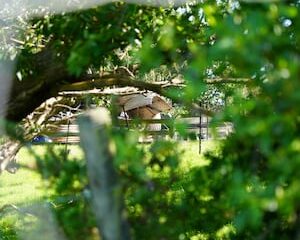
 World1 week ago
World1 week agoPrivate Funeral Held for Dean Field and His Three Children
-

 Top Stories2 weeks ago
Top Stories2 weeks agoFuneral Planned for Field Siblings After Tragic House Fire
-

 Sports3 months ago
Sports3 months agoNetball New Zealand Stands Down Dame Noeline Taurua for Series
-

 Entertainment3 months ago
Entertainment3 months agoTributes Pour In for Lachlan Rofe, Reality Star, Dead at 47
-

 Entertainment2 months ago
Entertainment2 months agoNew ‘Maverick’ Chaser Joins Beat the Chasers Season Finale
-

 Sports3 months ago
Sports3 months agoSilver Ferns Legend Laura Langman Criticizes Team’s Attitude
-

 Sports4 weeks ago
Sports4 weeks agoEli Katoa Rushed to Hospital After Sideline Incident During Match
-

 Politics2 months ago
Politics2 months agoNetball NZ Calls for Respect Amid Dame Taurua’s Standoff
-

 World2 weeks ago
World2 weeks agoInvestigation Underway in Tragic Sanson House Fire Involving Family
-

 Top Stories2 weeks ago
Top Stories2 weeks agoShock and Grief Follow Tragic Family Deaths in New Zealand
-

 Entertainment3 months ago
Entertainment3 months agoKhloe Kardashian Embraces Innovative Stem Cell Therapy in Mexico
-

 World4 months ago
World4 months agoPolice Arrest Multiple Individuals During Funeral for Zain Taikato-Fox

